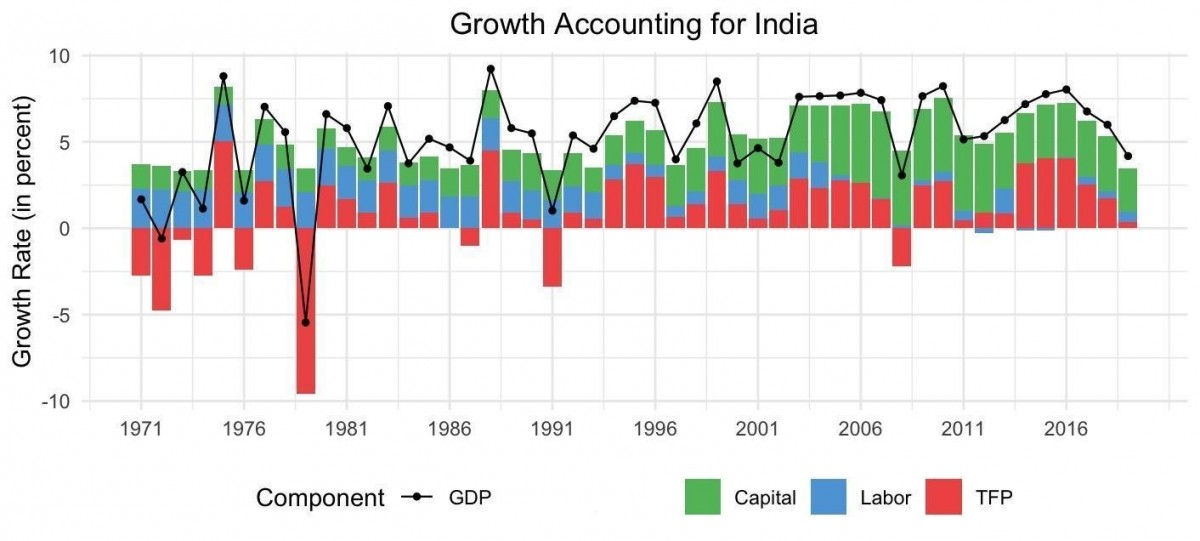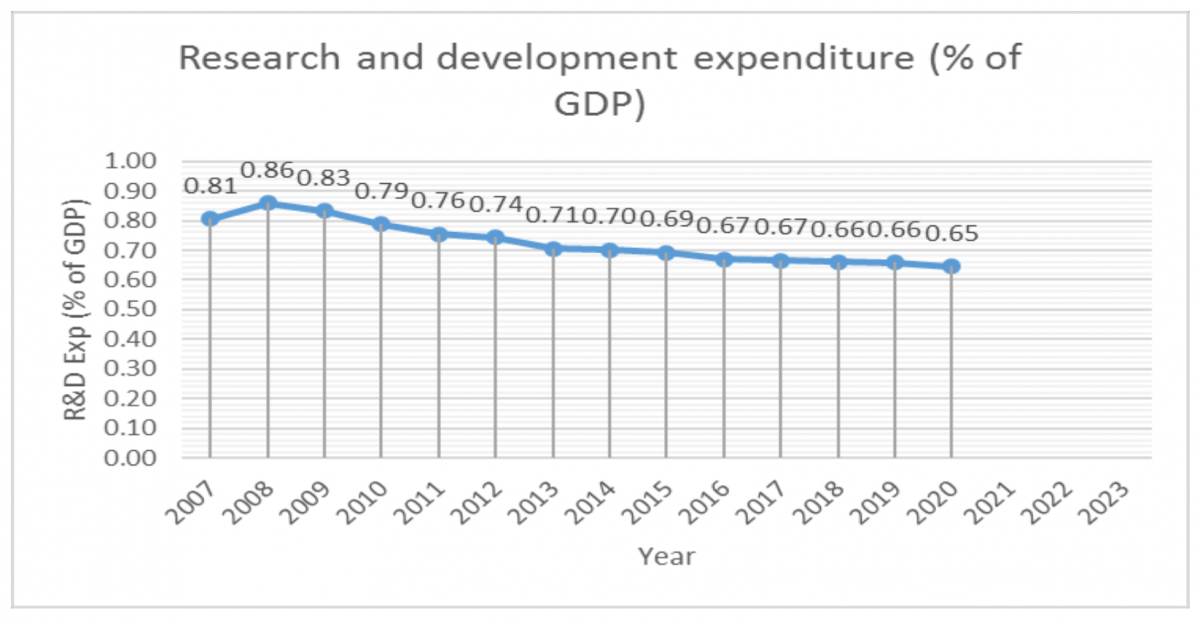Interpreting India's Middle-Income Trap Position and its Implications
As of now, 108 countries are classified as middle-income economies, comprising 75% of the global population, in the current international political and economic landscape, which is riddled with geopolitical tensions, shrinking economic growth and rising debt levels.
The World Development Report 2024 casts a dismal picture of India’s growth trajectory. The report states that it would take us nearly 75 years to set foot outside the threshold of the middle-income trap, our economy is currently embroiled in.
Until then, India’s path to transitioning to a high-income economy or Viksit Bharat remains marred by different challenges, layered in complexities of deep-entrenched inequities. However, this hypothesis is conditional, and can change, provided it moves away from its current strategy and adopts a new one.
In the 2024 World Development Report titled The Middle-Income Trap, identified middle-income countries are suggested to prioritise the ‘3Is’ strategy of "investment, innovation and infusion" for better, distributive growth benefits.
In a recent edition of its two-part series, team InfoSphere, an initiative by The Centre for New Economics Studies, seeks to offer a more comprehensive analysis of India’s middle-income trap position and the implications for its current growth trajectory.
A middle-income trap (MIT) is a situation in which middle-income countries are unable to transition to a high-income economy for a sustained period of time. Rapid growth, closely followed by a period of economic downturn, is indicative of an MIT.
Keeping this in mind, the paragraphs below provide a closer look into India’s growth trajectory, offering insights as we attempt to interpret what the data presents.
India’s classification as a middle-income economy
The World Development Report 2024 further elaborates on the causes and distinctions between high-income-level countries to those of low/middle income countries.
| High income | Low income |
| Population lower than 250 million | Population higher than 250 million |
| Lowering debt | Rising debt |
| Increase in free trade | Growing protectionism |
| High energy security | Energy transition |
| Capital intensive | Labor intensive |
Source: The 2024 World Development Report
Using per capita income or GNI per capita helps us in assessing the income level prevalent in a country. Focusing on ‘debt’, as classified under Low/Middle income countries given by the World Development Report 2024, we analyse its effect on per capita income in India.
As of June 26, 2024, India's external debt was $663.8 billion, which is a $39.7 billion increase from the end of March 2023. India's central government's internal debt was estimated to be around 131 trillion rupees in 2023, which is an increase from 2021 when it was around 99 trillion rupees.
Increased interest payments: Higher debt leads to more government spending on interest payments, reducing funds available for productive investments that boost economic growth and income.
Crowding out private investment: Extensive government borrowing can raise interest rates, making it costlier for businesses to invest, which slows economic growth and job creation, lowering per capita income.
Higher taxes and reduced spending: To manage debt, the government may increase taxes and cut spending on public services, both of which can reduce disposable income and economic activity, leading to lower per capita income.
A few years back, economist Rathin Roy cautioned that India’s growth was stagnating at lower-middle-income levels, with per capita income hovering between $1,000 and $3,800.
He highlighted that India's economic growth was largely fueled by demand from the top 100 million people, which he deemed unsustainable in the long term. However, Nicholas Stern argues that investments in sustainable infrastructure and energy transitions will spur robust investment and propel India’s future growth.
India’s middle-income trap
Factors that commonly contribute to a middle-income trap like difficulty in channeling technological innovations, reduction in labour participation and income inequalities are all challenges faced by India.

Figure 1. Source: Penn World Table 10.0, IMF- Unleashing India’s Growth Potential
Determinants of India’s growth trajectory: Capital, total factor producitivity, labour and more…
To break past the middle-income threshold, macroeconomic indicators like TFP, GNI, capital outlays and R&D must be prioritised. The data collected from the Penn World Table 10.0, in Figure 1 presents India’s growth story from 1971 to 2019. The data shows the levels to which indicators like capital outlays, labour and TFP (Total Factor Productivity) contribute to India’s growth.
From 2000 until 2012, capital played a significant impact, with labour’s role decreasing continuously. Visibly, the role played by capital and TFP remains the most consistent since 2001, with downturns during the financial crisis of 2007.
Recent literature suggests that TFP and capital outlays have had the most significant impact in deciding India’s growth since the move towards liberalisation and firm-friendly reforms in the 1980s.
Navigating the way forward

Figure 2. Source: UNESCO Institute for Statistics (UIS)
The strong link between TFP and R&D has long been discussed in academia. In applying this to India’s scenario, the 3I’s are crucial for India to move towards transitioning out of its middle-income trap. As of 2020, India’s R&D expenditure stood at 0.65% of its GDP in its trend of a gradual decline in R&D spending.
In 2020-21 the GERD (Gross Expenditure on Research and Development) was 0.86%, declining from nearly 0.88%. By drawing attention to increases in R&D investment to ensure innovation, it would not only drive growth, but also facilitate job creation, human capital and labour participation that has had negligible improvements.
R&D alone created 42% more jobs in 2022, however, this is not sufficient, as India’s current labour participation statistics (LFPR) stand at 50.2% as of January-March 2024. India’s Innovation Index 2021 revealed that the overall spending by India in R&D has been relatively low and it was reflected in the share of expenditure with only R&D (GERD) which was 0.7% of GDP.
India’s spending on R&D is below compared to the USA (2.9%) and Israel (4.5%) with the latter having the highest spending in the world. One of the main reasons for the low spending on R&D is the lack of immediate results which will lead countries like India to divert their spending on the bigger issues like hunger, poverty etc without realising that these concerns could be reduced with more spending on R&D.
It is observed that the countries that spend less on GERD are not able to contain their human capital in the long run because as a result of low spending on R&D leads to fewer innovative opportunities which could lead to people moving to other countries for better opportunities, the phenomenon defined as brain drain which is very common in India and this places the country in a disadvantage as they are less competitive and their economy as a whole also gets affected.
Improving labour capacities
There is a need for creating better quality jobs that could help in utilising human skills because poor quality jobs have led to income inequality, limited technological advancement and low GDP which highlights the need for better quality jobs in place of the amount of jobs created. This also underscores the need for upskilling workers by investing in human capital which is equally important as investment in technology advancement.
It has been found that increasing the percentage of GDP spent on R&D leads to a decrease in the unemployment rate as it is revealed that creating good quality jobs could provide fair pay and utilisation of human skills which is a seen as driving factor to be more productive according to the research conducted by PwC.
India is witnessing a significant growth in India’s R&D from ₹6,01,968 million in 2010-11 to ₹12,73,810 million in 2020-21 which still is low when compared with other countries like South Korea (4.8%). So, it is important to invest in R&D as they are the major input in economic growth as it has an impact on productivity, employment and capital formation. The Central government is the major driving force of R&D in India while the private sector plays an important role in R&D spending in advanced countries which underscores the need for increased participation of state government and private sectors in R&D spending in India and to focus on research and technology development.
While countries that gained independence around the same time have gone on to become high-income nations, India's journey has been more uneven. Recent economic trends suggest that India may be at risk of falling into this trap, where it struggles to sustain growth and fails to make the leap to a high-income economy. This raises a critical question: Can India become rich before its population grows old? Addressing this challenge is crucial for ensuring that India can capitalize on its demographic dividend and avoid the stagnation seen in other middle-income countries.
India's economic growth, though impressive in many respects, has shown signs of slowing in recent years. Despite significant strides in various sectors, the country has struggled to maintain the momentum needed to transition from a middle-income to a high-income economy.
Indicators such as stagnant productivity growth, income distribution, and innovation indices reveal that India may be threatened by the middle-income trap, a persistent obstacle for developing nations. These challenges are exacerbated by structural inefficiencies in key areas like education, infrastructure, and industrial policy, which hinder India's ability to compete globally and sustain long-term growth.
The education system, for instance, remains underfunded and misaligned with industry needs, resulting in a workforce that lacks the necessary skills for high-value industries. India's investment in education, around 3% of GDP, pales in comparison to South Korea's 10%, highlighting a significant gap.
Moreover, infrastructure development, while improving, still faces hurdles in project implementation, coordination, and funding. These challenges limit connectivity and economic efficiency, further stalling progress. Additionally, India's historical focus on import substitution and extensive government control has led to inefficiencies, limiting global integration and the ability to foster innovation.
Deepanshu Mohan is a Professor of Economics, Dean, IDEAS, and Director, Centre for New Economics Studies (CNES). He is a Visiting Professor at London School of Economics and an Academic Visiting Fellow to AMES, University of Oxford.
The Centre for New Economic Studies, Jindal University, provided research inputs for the article.
This article went live on August twenty-fourth, two thousand twenty four, at eleven minutes past eleven in the morning.The Wire is now on WhatsApp. Follow our channel for sharp analysis and opinions on the latest developments.




